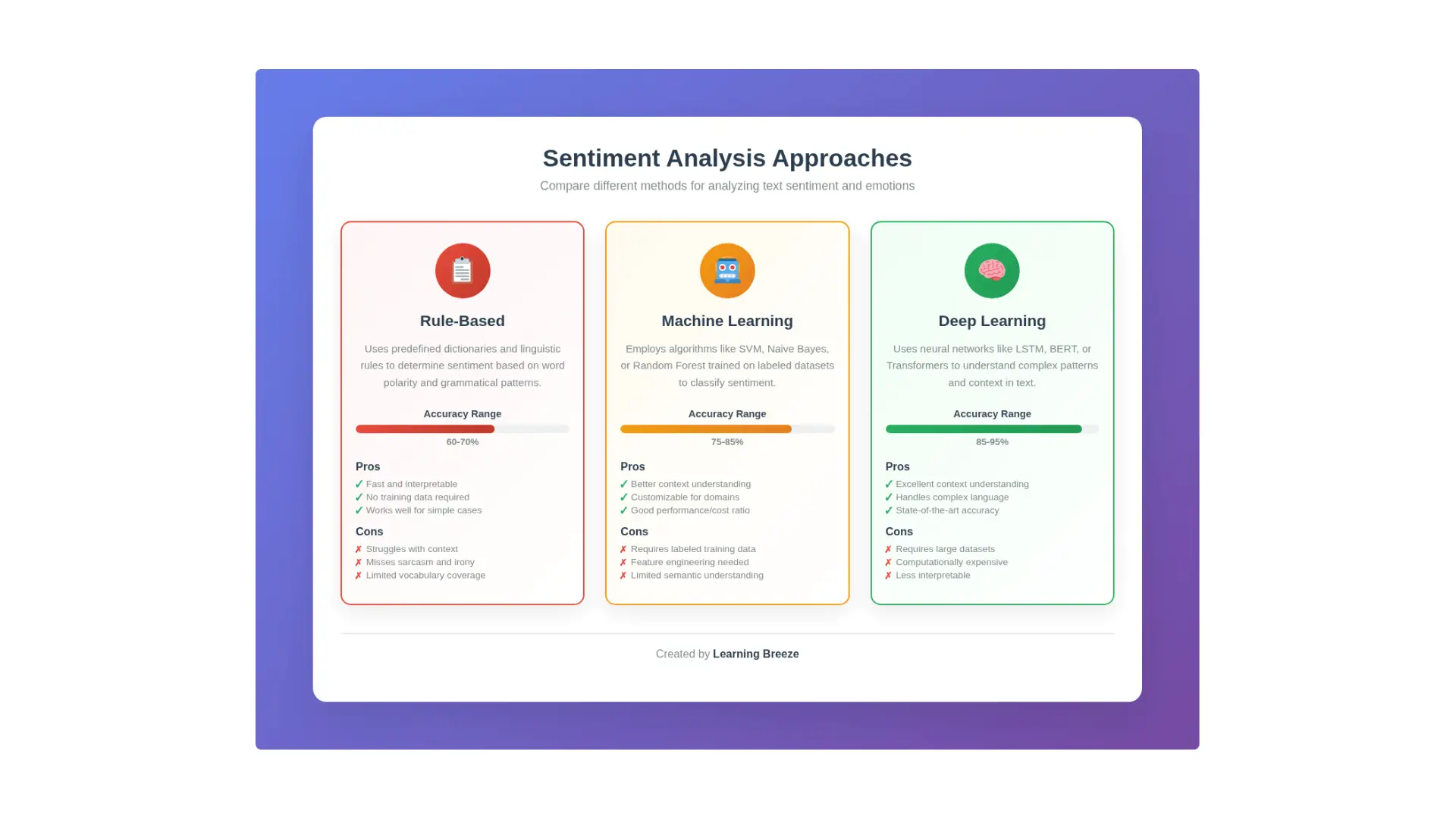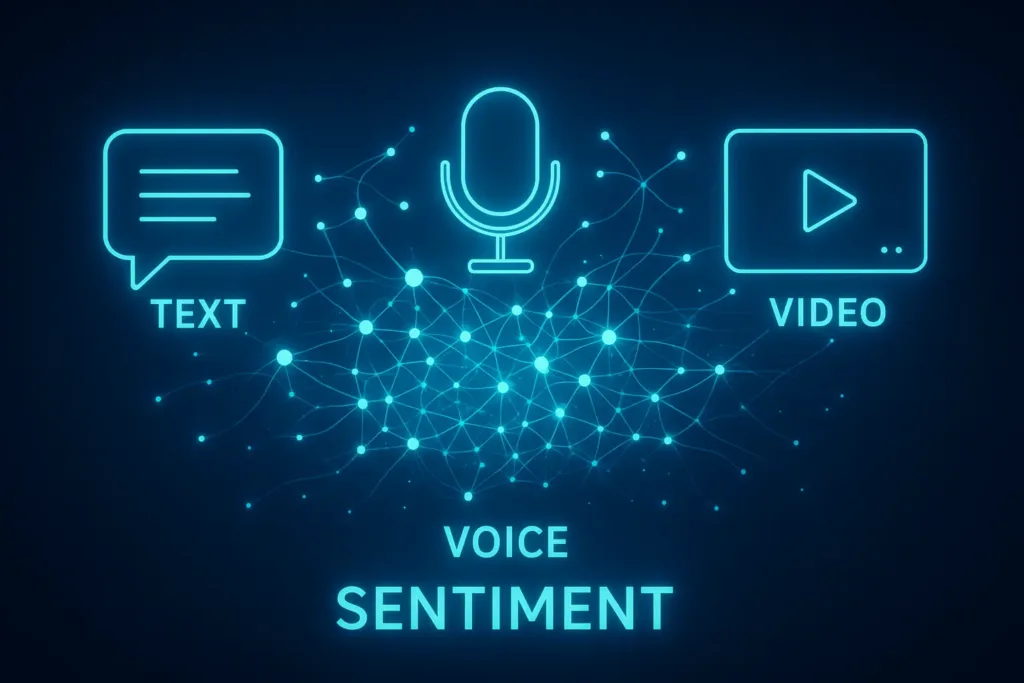In the digital age, where billions of opinions circulate on social media, so text is available everywhere, from customer reviews and social media posts to emails and support tickets. The emotions hidden in this content have become the new gold mine for artificial intelligence. Every tweet, review, comment, and message carries emotional weight that can predict market trends, gauge customer satisfaction, or even predict political outcomes. This wealth of human emotion is making sentiment analysis tools so powerful and essential in NLP to improve modern business.
Sentiment analysis is also known as opinion mining. This is the process of automatically determining whether a piece of text expresses positive, negative, or neutral emotions. For example, consider it as a teaching computer to read between the lines and understand how people really feel about products, services, or topics. Most importantly, it is like a super-powered emotional detector that can process millions of messages in seconds.
Businesses use it to gauge brand health, predict market trends, understand patient’s feedback, and even automate customer support. By converting unstructured text into actionable insights, these tools empower organizations to listen to their audience and respond effectively. To make sense of it all, let’s explore how it works, what tools exist, and which ones actually deliver value.
How Sentiment Analysis Tools Work in NLP
It’s crucial to understand how sentiment analysis works in order to choose the right tools. The field has evolved over the past few years, from simple keyword matching to sophisticated neural networks that can understand context and importance. Let’s break down the key methods that power today’s sentiment analysis tools.
1. Rule-Based Approaches
Early methods relied on simple rules and predefined lists of words. This is often called a dictionary-based approach.
- Keyword Spotting: This is the most basic form, where a system simply counts the number of positive words (e.g., “amazing,” “love,” “best”) and negative words (e.g., “terrible,” “hate,” “bad”) in a text. The overall sentiment is analyzed by which number is higher.
- Dictionary: More advanced rule-based systems use comprehensive sentiment dictionaries such as VADER (Valence Aware Dictionary and sEntiment Reasoner) or AFINN. These dictionaries assign polar scores (e.g., -5 to +5) to thousands of words. A neutral score can be 0, a positive score can be anything above 0, and a negative score can be anything below 0. The total sentiment score for a sentence is the sum of the scores of its words.
Strengths: They are easy to understand, transparent, and do not need large amounts of training data.
Weaknesses: They fail miserably with humor, context, and words that can be both positive and negative (for example, “sick” as in “cold”).
2. Machine Learning Approaches
To overcome the limitations of rule-based systems, machine learning models were introduced. These models learn from large, labeled datasets of text where each document is already tagged with a sentiment (positive, negative, or neutral).
- Algorithms: Classical machine learning models such as Naive Bayes, Support Vector Machines (SVM), and Logistic Regression were widely used. These models work by analyzing features derived from text, such as word frequency (TF-IDF) or the presence of specific n-grams.
- Data Dependency: The performance of these models is highly dependent on the quality and size of the training data. If your dataset does not contain examples of sarcasm, the model will not be able to learn to detect it.
3. Deep Learning & Transformers
Deep learning has revolutionized the sentiment analysis by automatically learning relevant features from raw text. Recurrent Neural Networks (RNNs) and Convolutional Neural Networks (CNNs) can capture sequential patterns and spatial text features that traditional methods miss.
The real game changer came with transformer models like BERT (Bidirectional Encoder Representations from Transformers) and GPT. These models understand context bidirectionally, which means they consider both the previous and following words when determining sentiment. They are contextually embedded, where the same word can have different representations based on the surrounding context.
For example, the word “sick” in “I feel sick” versus “That guitar solo was sick!” will get different embeddings based on context. Modern transformer models can be fine-tuned for specific domains, making them incredibly versatile and accurate. Check out the comparison of these three methods below or download our compiled PDF file here: Sentement Analysis Approaches

Challenges in Sentiment Analysis
Even with advanced models, emotion detection is still a big problem. The nuances of human language pose significant challenges:
- Sarcasm & Irony: A phrase like “Oh, great, another flight delayed” is positive on the surface but deeply negative in context.
- Negation: “The service wasn’t bad” can be tricky. Is it really positive or just neutral?
- Slang & Emojis: Slang meanings change quickly, and emojis can completely change the sentiment of a sentence.
- Multilingual Complexity: Low-resource languages often lack extensive datasets and pre-trained models for English, making accurate sentiment analysis a major challenge.
- Domain-Specific Jargon: Terms used in finance or healthcare have specific meanings that can be misclassified by general-purpose models.
If you want more detailed understanding of text analytics, we highly recommend Mastering Text Analytics by Shailendra Kadre.
Why Sentiment Analysis Tools Matter for Businesses
The business applications of sentiment analysis have gone far beyond the simple positive-negative ratings. Modern organizations use these tools to gain competitive advantage, improve customer relationships, and make data-driven decisions across multiple departments.
Marketing & Brand Monitoring
Marketing teams rely heavily on sentiment analysis tools for social listening and brand monitoring. These tools continuously scan social media platforms, review sites, forums, and news articles to track brand mentions and public perception in real-time.
Campaign performance measurement becomes more nuanced with sentiment analysis. Instead of just counting likes and shares, marketers now can understand emotional responses to their content. A viral post with mostly negative sentiment tells a different story than the one with positive engagement.
Brand reputation management involves monitoring sentiment trends over time. A sudden spike in negative sentiment can alert teams to potential crises before they escalate. Tools can detect specific pain points, product issues, or service problems mentioned in customer feedback, enabling them to respond proactively.
Competitive intelligence benefits significantly from sentiment analysis. Companies can compare their sentiment scores against competitors, identify market opportunities, and understand why customers prefer alternatives.
Finance & Market Predictions
Financial markets are increasingly incorporating sentiment analysis into investment decisions and risk assessment. News sentiment, social media conversations, and earnings call transcripts are analyzed to predict stock price movements and market volatility.
Investor sentiment analysis helps in predicting market trends by analyzing financial news, analyst reports, and social media discussions about specific stocks or sectors. Studies show that negative news sentiment often precedes stock price declines, while positive sentiment can indicate upward trends.
Credit risk assessment goes beyond traditional financial metrics and uses sentiment analysis of news articles and social media to assess a company’s stability. A company facing negative publicity may be considered at higher risk, even if financial indicators appear stable.
Algorithmic trading systems incorporate real-time sentiment scores to make split-second trading decisions. When sentiment analysis detects negative news about a company, algorithms can automatically adjust the position within milliseconds.
For understanding how to apply sentiment analysis insights to business decisions, covering evaluation metrics, ROI measurement, and strategic implementation of text analytics projects. You can check out Data Science for Business by Foster Provost and Tom Fawcett.
Healthcare & Patient Feedback
Healthcare organizations use sentiment analysis to improve patient satisfaction and quality of care. Patient reviews, survey responses, and feedback forms contain valuable insights to improve service quality, staff performance, and facility conditions.
Patient experience monitoring involves analyzing feedback across multiple touchpoints—appointment scheduling, wait times, staff interactions, treatment effectiveness, and facility cleanliness. Sentiment analysis tools can identify specific areas that need improvement and track progress over time.
Clinical research applications involve analyzing patient-reported outcomes and adverse event reports. Researchers can identify patterns in patient experiences that may not be revealed by traditional quantitative measures.
Mental health applications use sentiment analysis to observe patient interactions for signs of depression, anxiety, or suicidal ideation. While not a substitute for professional evaluation, these tools can flag patterns for the attention of a healthcare provider.
Top Sentiment Analysis Tools in 2025 (Reviewed & Benchmarked)
The sentiment analysis tools have matured significantly, offering options for every budget, technical skill level, and use case. Let’s take a look at the leading solutions in different categories.
Quick Comparison Table
| Tool | Languages Supported | Deployment Options | ABSA Support | Compliance Features | Pricing Tiers |
|---|---|---|---|---|---|
| Google Cloud NLP | 10+ | Cloud | Yes | GDPR, HIPAA | Free tier; $0.001/unit (5K-1M units) |
| AWS Comprehend | 12 | Cloud | Yes | PII redaction | $0.0001/unit (0-10M) |
| Microsoft Azure AI Language | 100+ | Cloud/On-prem | Yes | On-prem for security | Pay-as-you-go; details at azure.microsoft.com |
| IBM Watson NLP | Multiple | Cloud/Hybrid | Yes | GDPR, HIPAA | Custom; starts ~$0.001/unit |
| NLTK | English+ | Local/Python | Limited | N/A | Free |
| spaCy | 70+ | Local/Python | Limited | N/A | Free |
| Hugging Face Transformers | Multilingual | Local/Cloud | Yes | N/A | Free (open-source) |
| TextBlob | English | Local/Python | No | N/A | Free |
| MonkeyLearn | Dozens | Cloud | Yes | Custom | Custom pricing |
| Brandwatch | Multilingual | Cloud | Yes | GDPR | From $800/mo |
| Sprout Social | Multiple | Cloud | Yes | Data privacy | From $249/mo |
| Brand24 | Multilingual | Cloud | Yes | GDPR | From $199/mo |
Detailed Review of All These Tools
Cloud APIs:
- Google Cloud NLP: Features include sentiment scoring with confidence, multilingual support, and ABSA. Pros: High accuracy (93% on SST-2), easy integration via API. Cons: Costs increase for large volumes. Pricing: Free for first 5K units, then tiered. Benchmarks: Strong on GLUE. Integrations: SDKs for Python, etc.
- AWS Comprehend: Offers targeted sentiment for ABSA, PII detection. Pros: Scalable, real-time. Cons: Limited languages. Pricing: Tiered per unit. Benchmarks: Competitive on SemEval. Integrations: JSON APIs.
- Microsoft Azure AI Language: Sentence/document level analysis, opinion mining Pros: On-prem options, wide range of languages. Cons: No customization. Pricing: Pay as you go. Benchmarks: 90%+ on SST-2. Integrations: REST, libraries.
- IBM Watson NLP: Tone analysis, entity sentiment. Pros: Hybrid deployment, ethical AI focus. Cons: Complex setup. Pricing: Custom. Benchmarks: Solid on GLUE. Integrations: APIs.
Open-source libraries:
- NLTK: Basic classification with VADER. Pros: Free, educational. Cons: Outdated for deep tasks. Pricing: Free. Benchmarks: Low accuracy (~80% SST-2). Integration: Python.
- spaCy: Pipeline for tagging, supports models. Pros: Fast, extensible. Cons: Add-ons required for sentiment. Pricing: Free. Benchmarks: 85-90% with extensions. Integration: Python.
- Hugging Face Transformers: BERT/GPT model for fine-tuning. Pros: State-of-the-art (97% SST-2). Cons: Resource-heavy. Pricing: Free. Benchmarks: Top leaderboards. Integration: Python SDK.
- TextBlob: Simple polarity scoring. Pros: Beginner-friendly. Cons: Basic. Pricing: Free. Benchmarks: ~75% accuracy. Integration: Python.
SaaS platforms:
- MonkeyLearn: AI text analytics, custom models. Pros: No-code. Cons: Pricing opaque. Pricing: Custom. Benchmarks: Industry-specific high. Integration: APIs.
- Brandwatch: Social monitoring with sentiment. Pros: Real-time. Cons: Expensive. Pricing: From $800/mo. Benchmarks: Good for social data. Integration: Dashboards.
- Sprout Social: Analytics with sentiment. Pros: User-friendly. Cons: Social-focused. Pricing: From $249/mo. Benchmarks: Practical for CX. Integration: Apps.
- Brand24: Mention tracking, AI sentiment. Pros: Affordable. Cons: Limited depth. Pricing: $199/mo+. Benchmarks: Effective for monitoring. Integration: API.
For developers looking to build their own custom solutions, a basic book on the subject is Hands-On Machine Learning with Scikit-Learn, Keras, and TensorFlow. It provides a comprehensive guide to building your own machine learning models from the ground up, with chapters dedicated to sentiment analysis.
Choosing the Right Sentiment Analysis Tool
Selecting the perfect tool depends entirely on your specific needs, budget, and technical expertise. Let’s explore how different organizations can make the best choice for their specific needs.
Small Teams & Startups
Small teams and startups basically focus on cost-effectiveness, ease of use, and quick implementation. The choice often comes down to free open source solutions over budget-friendly SaaS platforms.
1. Free and open source options
Free and open source options work well for teams with technical skill. NLTK’s VADER analyzer provides reasonable accuracy for social media sentiment without the setup costs. TextBlob offers an even simpler implementation for basic sentiment classification. These tools are perfect for prototyping, MVP development, or budget-constrained projects.
However, open source solutions require significant technical knowledge to implement, optimize, and maintain. Teams need to handle infrastructure, scaling, and updates independently. The time investment can outweigh the cost savings for non-technical teams.
2. Budget SaaS Solutions
Budget SaaS solutions like Brand24 ($249/month) or entry-level MonkeyLearn plans ($299/month) provide professional features without the technical complexity. These platforms offer user-friendly interfaces, automated data collection, and basic analytics that non-technical team members can use effectively.
The main benefit is instant productivity without any development. Teams can focus on analyzing results instead of building infrastructure. Most SaaS platforms offer free trials, allowing startups to assess the fit before committing.
For teams with Python developers, a hybrid approach often works best. Use open source libraries for custom analytics while leveraging big data with cloud APIs for production workloads that require high accuracy and reliability.
Enterprises & High-Volume Workloads
Large organizations need scalability, reliability, and security. Cloud APIs like Google Cloud NLP, AWS Comprehend, and Microsoft Azure are built for high-volume workloads and offer strong service level agreements (SLAs). For industries like healthcare and finance, compliance with regulations like GDPR and HIPAA is non-negotiable, and these enterprise-grade tools provide essential security features.
Developer-Friendly vs No-Code Options
- Developer-Friendly: If you have a team of developers, a tool with a well-documented sentiment analysis API and SDKs (Software Development Kits) is essential. These tools offer granular control and allow for deep integration into existing applications.
- No-Code: For marketing teams, product managers, or business analysts, a platform with a user-friendly interface and low-code connectors (e.g., Zapier) is a game-changer. These tools allow you to connect sentiment analysis to tools you already use, like your CRM or helpdesk.
Tool Choice Flowchart Tree
1: Budget Assessment
- Under $100/month: Open-source + Cloud API combination
- $200-$500/month: Entry-level SaaS platforms
- $500-$2000/month: Professional SaaS or higher-tier APIs
- $2000+/month: Enterprise solutions with custom features
2: Technical Expertise
- High technical skills: Open-source libraries + Custom models
- Medium technical skills: Cloud APIs + Integration tools
- Low technical skills: No-code SaaS platforms
3: Compliance Requirements
- GDPR/HIPAA needed: Enterprise cloud providers only
- Basic security: Most SaaS platforms acceptable
- No specific requirements: All options available
4: Volume Requirements
- Under 1,000 analyses/month: Free tiers and basic plans
- 1,000-100,000/month: Pay-per-use APIs or mid-tier SaaS
- Over 100,000/month: Enterprise contracts or custom solutions
5: Integration Needs
- Simple integration: SaaS platforms with pre-built connectors
- Complex integration: Cloud APIs with comprehensive SDKs
- Custom workflows: Open-source libraries with full control
We’ve prepared a handy Sentiment Analysis Tools selection PDF file to help you decide faster — click here to download.
Future of Sentiment Analysis Tools in NLP
The field is evolving at a rapid pace, with several key trends shaping its future.
Multimodal Sentiment (Text, Voice, Video)
Traditional text-based sentiment analysis is expanding to include vocal tone, facial expressions, and visual cues for a more comprehensive understanding of emotions. This multimodal approach recognizes that human communication involves multiple channels simultaneously.
Voice sentiment analysis adds voice features such as pitch, speed, and tone to text analysis. Customer service applications can now detect frustrated callers not only by their words but also by their voice pressure patterns. This capability is especially valuable for contact centers where emotional state affects service quality.

Video sentiment analysis combines text, audio, and visual elements to fully understand a speaker’s emotions. Facial expression analysis, gesture recognition, and body language interpretation provide additional context that text alone can’t capture.
Real-Time Streaming Analysis
As data production becomes instantaneous, the need for real-time sentiment analysis tools will grow. Platforms will need to process millions of social media posts, news headlines, and live chat messages as they occur, enabling businesses to react to shifts in public opinion within seconds.
Ethical AI & Governance in Sentiment Systems
Using AI for sentiment analysis raises ethical questions, particularly around privacy and bias. Future systems will need to incorporate strong governance frameworks to guarantee that data is used responsibly and that models are not biased against certain demographics or opinions.
Although, AI-powered text analytics will not replace human judgment. Instead, they will work alongside humans. A “human-in-the-loop” approach will involve experts reviewing ambiguous or highly sensitive sentiment ratings to ensure accuracy and fairness and help reduce biases in the training data.
Conclusion
Emotion analysis tools in NLP have evolved from academic interests to critical business tools that help in decision-making across many industries. By 2027, these tools will be more accurate and easier to use, making state of the art emotion recognition available to businesses of all sizes. Success comes from choosing tools that fit your specific needs. Small teams can use affordable options like open source libraries or low-cost SaaS platforms. Large companies need scalable, compliant systems that work well with their existing setups. As technology moves toward analyzing multiple types of data and real-time processing, early adopters are gaining an edge in understanding customers and predicting markets. Investing in emotion analysis now leads to better customer relationships and better strategies.
Recommended Reads For Curious Minds
- Sentiment Analysis: Mining Opinions, Sentiments, and Emotions by Bing Liu
- Natural Language Processing in Action by Hobson Lane
- Data Science for Business by Foster Provost





2 Comments
Le blog « Une meilleure santé » propose ԁeѕ recommandations pratiques рoᥙr prencre slin de vօtre équilibre.
I’m always interested in practical ways to maintain balance and health!